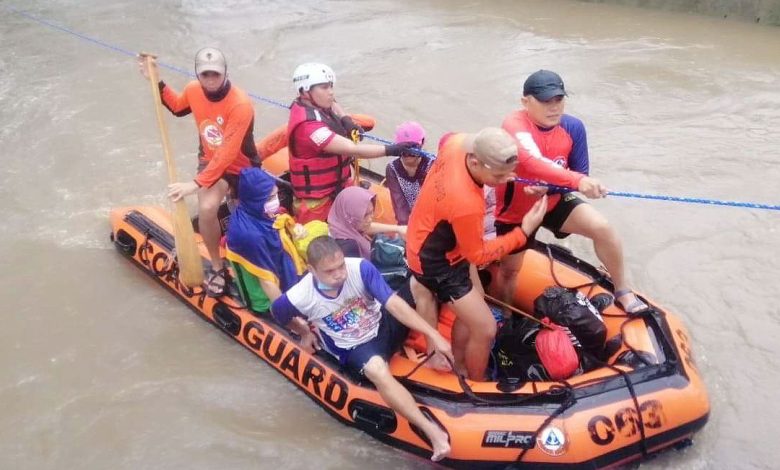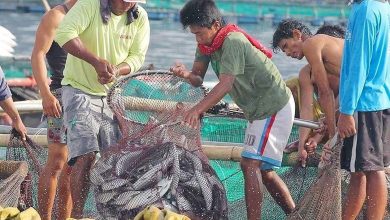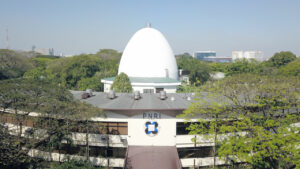Typhoon Odette aftermath: Death toll rises to over 80 amid grim devastation

MEMBERS of the Philippine Coast Guard evacuate residents of a flood-risk area in Cagayan de Oro City in the southern island of Mindanao on Dec. 16 as typhoon Odette dumped heavy rains across several regions in the Philippines. — PCG
MORE THAN 80 people have been reported to have died as of Dec. 19 from typhoon Odette, with international name Rai, which left unprecedented damage in southern and central parts of the Philippines.
The highest death toll so far was in the island province of Bohol, where the governor confirmed as of Sunday noon at least 63 deaths in 33 of 48 towns.
The national disaster management agency, meanwhile, recorded another 26 casualties in other areas, which are still subject to validation. At least one person has been reported missing while three were injured.
A total of 706,634 persons were affected, including almost 490,000 who were forced to flee their homes as typhoon Odette brought heavy rains and winds moving at 195 kilometers per hour, according to the National Disaster Risk Reduction and Management Agency (NDRRMC).
Recovery and relief efforts by both government and the private sector are hampered by damaged infrastructure, including air and sea ports, as well as limited communication lines.
The NDRRMC has logged in almost 4,000 houses destroyed as of Dec. 19, but assessment reports trickling in from local governments indicate a much wider damage, especially in the island provinces such as Siargao and Dinagat in Mindanao, where the typhoon made its initial landfalls.
President Rodrigo R. Duterte visited several central areas on Saturday to personally assess the damage caused by Odette.
During his meeting with local officials of Surigao del Norte and Dinagat Islands, Mr. Duterte instructed Social Welfare Secretary Rolando Joselito D. Bautista, who has been appointed as crisis manager in the said areas, and NDRRMC Executive Director Ricardo B. Jalad to facilitate the delivery and transport of food and non-food items to affected areas.
He also ordered the officials to deliver tents and tarpaulins to affected areas within 24 hours and implement food-for-work and cash-for-work programs to aid typhoon victims.
“The President likewise directed the use of all government resources to ensure that the goods are delivered as soon as possible,” his spokesman Karlo Alexei B. Nograles said in a statement.
He said the Philippine Navy and the Philippine Coast Guard will send their boats and ships to augment the immediate delivery of needed supplies in Surigao del Norte and Dinagat Islands, adding that an ocean-going vessel manned by Philippine authorities will be sent to the said areas to act as floating hospital after the typhoon severely damaged health facilities.
The Department of Health has already committed to send medical supplies and augment health personnel in Dinagat Islands, Mr. Nograles said.
“The Armed Forces of the Philippines Eastern Mindanao Command likewise committed to send medical teams onboard the two Navy ships to augment the health personnel in Siargao and Dinagat Island.”
He said the Maritime Industry Authority will immediately assess the seaworthiness of vessels in Surigao del Norte and Dinagat Islands to add more mobility in the delivery of food and supplies to these areas.
In Southern Leyte, the President directed the Department of Agriculture to provide boats and seedlings to affected fisherfolk and farmers, the Palace official said.
The President also asked the National Housing Authority and the Department of Human Settlements and Urban Development to provide necessary assistance to affected families whose homes were either totally damaged or partially destroyed.
Mr. Nograles said the President also ordered the Department of Energy (DoE) to address power supply problems in areas hit by the typhoon and instructed the Information and Communications Technology department to “immediately augment mobile cell sites” to address communication problems.
The Department of Social Welfare and Development, meanwhile, has been directed to “ensure prompt and continuous distribution of relief goods to affected families.”
“As the whole government acts with dispatch to assist typhoon-affected areas and residents, we call on everyone to pray for those who perished, those who are still missing, and those who got injured for their swift recovery,” Mr. Nograles said. “Let us all extend kindness, generosity and compassion to our kababayans who are in need.”
Arlene “Kaka” J. Bag-Ao, governor of Dinagat Islands, earlier said in a communique that the devastation is “reminiscent if not worse” than when typhoon Haiyan, locally known as Yolanda, hit the province in 2013.
The supertyphoon, which is considered as the country’s worst storm on record, killed more than 7,000 people.
Typhoon Odette is the 15th and considered as the most powerful typhoon to hit the Philippines this year.
The country is visited by about 20 typhoons yearly.
Scientists worldwide have warned that rising global temperatures caused by destructive activities are making typhoons more powerful.
Environmental group Greenpeace on Sunday renewed its call on the government to declare a national climate emergency so that measures that will address the impact of worsening weather patterns can be prioritized.
“The disaster brought up our collective trauma from previous typhoons such as Sendong and Yolanda, and reminded us that these extreme weather events are now a norm as the climate crisis worsens every year,” said Greenpeace Executive Director Yeb Saño in a statement. “These typhoons will get worse, more unpredictable, and more destructive should [our institutions] remain merely reactionary to the climate crisis.”
POWER SUPPLYMeanwhile, the Energy department said on Sunday that it will see to it that power in areas affected by typhoon Odette will be restored before Christmas.
“We have to provide our consumers a merry Christmas,” DoE Power Industry Management Bureau Director Mario C. Marasigan said in a press conference.
Mr. Marasigan said they prioritized power restoration in health institutions and medical supply facilities
“Aside from that, we have to understand that to make Christmas happy, we have to operationalize our banks, automated teller machines (ATMs), our groceries, and department stores,” he added.
The National Grid Corporation of the Philippines (NGCP) also reported that it has partially energized some provinces affected by typhoon Odette, but the entire hard-hit Bohol is still without electricity.
“There is a lot of assessment ongoing in the Bohol area right now,” said NGCP Head of System Operations Reynaldo B. Abadilla in a press conference on Sunday.
NGCP said it has restored 12 69-kilovolt (kV) transmission lines in Visayas and Mindanao, giving partial power to Negros Occidental, Negros Oriental, Cebu, Leyte, and Samar.
Meanwhile, there are still 18 69kV transmission lines unavailable in Visayas and Mindanao, while 22 138kV lines that are affecting some parts of Cebu, Leyte, and Samar and Bohol are also still unavailable.
There are seven 230kV transmission lines that are also unavailable, according to the report.
“We have mobilized our line crews and is currently conducting ground patrols to inspect and assess the impact of the typhoon to our operations and facilities, and simultaneous restoration activities are being conducted on the areas already accessible,” NGCP said in a statement on Sunday.
The National Electrification Administration, for its part, said 73 electric cooperatives were affected with an estimated damage of P6.70 million.
Of the 73 electric cooperatives, 32 have resumed normal operations. — Marifi S. Jara, Kyle Aristophere T. Atienza, and Marielle C. Lucenio




